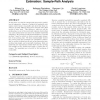Free Online Productivity Tools
i2Speak
i2Symbol
i2OCR
iTex2Img
iWeb2Print
iWeb2Shot
i2Type
iPdf2Split
iPdf2Merge
i2Bopomofo
i2Arabic
i2Style
i2Image
i2PDF
iLatex2Rtf
Sci2ools
127
Voted
IMC
2004
ACM
2004
ACM
Single-hop probing asymptotics in available bandwidth estimation: sample-path analysis
In this paper, we take the sample-path approach in analyzing the asymptotic behavior of single-hop bandwidth estimation under bursty cross-traffic and show that these results are provably different from those observed under fluid models of prior work. This difference, which we call the probing bias, is one of the previously unknown factors that can cause measurement inaccuracies in available bandwidth estimation. We present an analytical formulation of “packet probing,” based on which we derive several major properties of the probing bias. We then experimentally observe the probing bias and investigate its quantitative relationship to several deciding factors such as probing packet size, probing train length, and cross-traffic burstiness. Both our analytical and experimental results show that the probing bias vanishes as the packet-train length or packet size increases. The vanishing rate is decided by the burstiness of cross-traffic. Categories and Subject Descriptors C.2.3 [N...
| Added | 30 Jun 2010 |
| Updated | 30 Jun 2010 |
| Type | Conference |
| Year | 2004 |
| Where | IMC |
| Authors | Xiliang Liu, Kaliappa Nadar Ravindran, Benyuan Liu, Dmitri Loguinov |
Comments (0)

